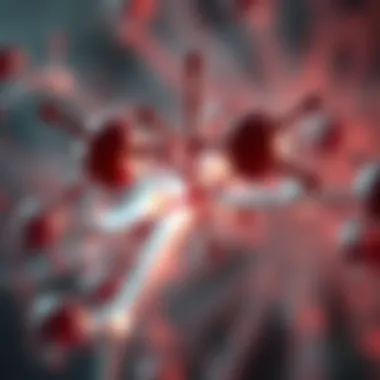Acthar in Sarcoidosis Treatment: Insights and Implications


Intro
Sarcoidosis is a complex systemic condition defined by the formation of granulomas in various organs. This often leads to a jumble of overlapping symptoms, ranging from fatigue to significant respiratory issues, complicating diagnosis and treatment. Amidst the evolving landscape of sarcoidosis management, Acthar has emerged as a noteworthy contender. This article aims to unpack the clinical and therapeutic roles of Acthar in the treatment of sarcoidosis, providing healthcare professionals with a thorough understanding of its mechanisms, benefits, and withal, its limitations.
As the understanding of sarcoidosis continues to grow, the necessity for nuanced treatment approaches becomes evident. Not just a catchphrase in the medical community, Acthar, also known as Acthar Gel, harnesses the power of adrenocorticotropic hormone (ACTH) to modulate the immune response. Therefore, understanding its roles isn't just academic; it's about navigating real-life patient care and improving quality of life. Armed with detailed insights, we hope to clarify how Acthar fits into the multifaceted puzzle of sarcoidosis management.
Research Highlights
Key Findings
- Mechanism of Action: Acthar works at the level of the central nervous system, prompting the adrenal cortex to secrete cortisol, which in turn attenuates inflammation and immune responses. This mechanism illustrates its potential effectiveness in managing sarcoidosis-related inflammation.
- Clinical Trials: Recent studies have shown promising results, indicating that Acthar administration can lead to significant improvements in specific sarcoidosis symptoms. The data also suggests its use can result in fewer side effects compared to traditional glucocorticoid therapies.
- Patient Outcomes: Case studies highlight substantial patient improvements in pulmonary function and overall quality of life. These anecdotes are not mere exceptions but part of a growing body of evidence supporting Acthar’s role in treatment regimens.
Implications and Applications
- Integration into Treatment Plans: With its unique action, Acthar can potentially serve as a cornerstone in managing sarcoidosis, especially for patients who do not respond well to standard therapies. Keeping patients’ varied responses in mind can influence prescribing practices.
- Risk Management: While Acthar appears beneficial, awareness of possible side effects is essential. The discussion about integrating this therapy should always factor in patient-specific variables like concurrent conditions or medications, leading to a tailored approach to treatment.
Understanding the nuances of sarcoidosis management is crucial to improving outcomes, and Acthar provides another option worth exploring.
Methodology Overview
Research Design
The investigation into Acthar's efficacy in sarcoidosis management utilized a mixed-methods approach. Researchers employed both quantitative data from clinical trials and qualitative insights from patient case studies.
Experimental Procedures
- Clinical Data Analysis: A thorough review was conducted on multiple recent trials examining the effectiveness of Acthar in treating sarcoidosis. Parameters included base line health, response rates, and any adverse events noted during therapy.
- Patient-Centric Case Studies: Gathering narratives from healthcare providers and their patients who have experienced Acthar provided rich qualitative insights into real-life implications of the therapy. These accounts, combined with clinical findings, yield a holistic view on its application.
For more information on the clinical applications of Acthar in sarcoidosis, resources such as PubMed, and National Institutes of Health can provide further literature and studies for exploration.
Foreword to Sarcoidosis
Understanding sarcoidosis is akin to peeling an onion—each layer reveals more about this complex condition. Sarcoidosis is not just a single disease; it’s a diagnostic puzzle that affects millions, making it crucial for both healthcare providers and patients to grasp its nuances thoroughly. This section lays the groundwork for the readers by providing significant definitions, demographic insights, and underlying biological mechanisms. With knowledge, one can navigate the complexities of sarcoidosis treatment, setting the stage for discussions about therapeutic approaches like Acthar.
Defining Sarcoidosis
Sarcoidosis is a systemic condition characterized by the formation of granulomas, which are clusters of inflammatory cells. These granulomas can appear in various organs, such as the lungs, eyes, skin, and lymph nodes. The exact cause of sarcoidosis remains elusive, but it often presents symptoms like cough, shortness of breath, fever, and fatigue. It can be a burden for many; , it often goes undiagnosed for long periods, as its symptoms can mimic other conditions. Understanding what sarcoidosis is in detail is essential for identifying it early and discussing viable treatments.
Epidemiology and Prevalence
Epidemiologically, sarcoidosis is more common than one might think. Research indicates that it predominantly affects adults between the ages of 20 and 40, with a higher prevalence in African-Americans compared to Caucasians. For instance, while the overall prevalence in the United States is about 10-20 cases per 100,000, in African-American populations, this figure can be as high as 50 cases per 100,000. Geographic variations also exist, with higher rates observed in northern European countries. Understanding the demographics can aid in early identification and prompt management of the disease.
Pathophysiology of Sarcoidosis
Delving into the pathophysiology of sarcoidosis reveals critical details that inform treatment strategies. The precise mechanisms remain under exploration; however, it’s widely recognized that an aberrant immune response plays a crucial role. Genetic susceptibility, environmental triggers, and infectious agents may all contribute to the activation of T lymphocytes and macrophages. The activity of these immune cells leads to granuloma formation, disrupting normal tissue function. For example, when granulomas form in the lungs, they impair gas exchange, leading to respiratory complications.
"Understanding the pathophysiology of sarcoidosis is essential for crafting effective management plans, providing the link between symptoms and therapeutic interventions."
In essence, unpacking sarcoidosis's complexities—from basic definitions and epidemiological insights to the intricated biological processes—prepares readers for a deeper exploration of targeted therapies like Acthar, which will be discussed in later sections.
Prologue to Acthar
The treatment landscape for sarcoidosis, with its myriad of clinical manifestations, necessitates a thorough understanding of the therapeutic options available. One such option, Acthar, has garnered attention for its potential therapeutic roles, particularly in managing inflammation associated with this disease. Acthar Gel is not just a run-of-the-mill medication; it brings specific attributes to the table that could aid healthcare professionals in tailoring treatment strategies for diverse patient profiles.


When discussing Acthar, it's vital to note its origins and the broader implications of its application. It is derived from naturally occurring pituitary hormone, adrenocorticotropic hormone (ACTH). This implies a unique mode of action that places it in a different category compared to standard corticosteroids. Given that sarcoidosis often flares due to heightened immune responses, Acthar's influence on this response presents a significant area for exploration. The following subsections will delve into the specifics of what Acthar Gel is, as well as elucidating its mechanism of action.
Overview of Acthar Gel
Acthar Gel, also known as H.P. Acthar Gel, is a formulation of ACTH that is primarily used for various debilitating conditions, including sarcoidosis. Unlike traditional corticosteroids, which are broadly administered and can lead to multiple side effects, Acthar has a more nuanced approach to treatment. Many consider it a second-line therapy, suitable for patients who might not respond adequately to conventional therapies or who experience adverse effects from them.
One unique charm of Acthar Gel is its FDA approval, which extends beyond just sarcoidosis to include conditions such as multiple sclerosis and certain types of infantile spasms. Its versatility makes it an interesting option for practitioners looking to navigate complex cases where standard treatments might fall short.
In terms of administration, Acthar Gel is typically given via intramuscular or subcutaneous injection, a method that underscores its potent nature and underscores the need for healthcare providers to monitor responses closely. Furthermore, the storage requirements are relatively straightforward, being stable at room temperature until opened, which can facilitate easier management in clinical settings.
Mechanism of Action
The mechanism of action of Acthar is where it becomes particularly intriguing. For sarcoidosis, it acts principally through stimulation of the adrenal cortex to increase cortisol production. This increase in endogenous corticosteroids ultimately leads to a reduction in inflammation and immune response, which are hallmark features of sarcoidosis pathology.
While many might assume that all glucocorticoid treatments have similar mechanisms, Acthar distinguishes itself by eliciting a range of effects that might influence multiple physiological pathways. Here’s a breakdown of how Acthar operates:
- Stimulation of Cortisol Production: By stimulating the adrenal glands, Acthar promotes a significant uptick in cortisol levels, resulting in potent anti-inflammatory effects.
- Impact on Inflammatory Cytokines: Acthar modifies the generation and expression of various cytokines involved in inflammation, thereby modulating the immune response without blanket suppression.
- Potential Influence on Renal Function: There's some evidence to suggest that Acthar may have a protective role on renal function by minimizing perfusion pressures and reducing proteinuria, which can be particularly beneficial in sarcoidosis patients with kidney involvement.
In summary, the distinctive profile of Acthar Gel and its action presents an exciting avenue for treatment within the complex context of sarcoidosis. The nuances of its mechanism not only add depth to its understanding but also speak to its clinical applicability in tailored patient management.
Clinical Applications of Acthar
Understanding the clinical applications of Acthar is pivotal when examining its role in managing sarcoidosis. This segment delves into its use across various medical conditions, with a particular focus on autoimmune diseases and sarcoidosis itself. This knowledge can help healthcare professionals determine the therapeutic potential of Acthar in practice.
Acthar in Autoimmune Diseases
Autoimmune diseases arise when the body's immune system mistakenly attacks its own healthy cells. These diseases encompass a broad range, including rheumatoid arthritis, lupus, and multiple sclerosis, significantly impacting the lives of those affected. Acthar, though primarily known for its application in sarcoidosis, has gained attention as a versatile therapy in managing several autoimmune conditions.
The mechanism of action of Acthar can often be traced back to its ability to modulate the immune response. By stimulating the production of natural corticosteroids in the body, Acthar can help reduce inflammation and suppress overactive immune responses. This dual action offers a valuable treatment avenue for patients experiencing severe symptoms or those who don't respond well to traditional therapies such as corticosteroids.
- Effectiveness: Clinical observations suggest that Acthar can deliver favorable outcomes in autoimmune disease management.
- Administration: Acthar can be administered subcutaneously or intramuscularly, which offers flexibility depending on patient needs.
- Conditions Treated: While it has shown potential in numerous autoimmune conditions, further research is still needed to clarify its full spectrum of efficacy.
Use in Sarcoidosis
When it comes to sarcoidosis, Acthar presents a unique therapeutic option. Sarcoidosis can affect multiple organs: the lungs, skin, or lymph nodes being the most common. Treatment often hinges on managing symptoms and preventing long-term damage to affected tissues. Acthar has emerged as a possible alternative treatment for patients who either prefer to avoid traditional corticosteroids or have inadequate responses to them.
- Mechanism of Action in Sarcoidosis: Similar to its application in autoimmune diseases, Acthar helps to control the inflammatory pathways driven by the immune system. This response can lead to a reduction in granuloma formation, which is characteristic of sarcoidosis.
- Clinical Evidence: Various studies highlight the therapeutic benefits of Acthar in improving patient symptoms and overall well-being. One study noted a significant percentage of patients reporting reduced symptoms when using Acthar compared to a placebo group.
- Safety Profile: Although the safety and side effects of Acthar are essential, understanding its full impact on sarcoidosis patients is crucial for informed decision-making in clinical settings.
As sarcoidosis management progresses, the inclusion of Acthar therapy provides additional options for healthcare providers. The key is to evaluate individual patient conditions and survey possible benefits versus risks carefully. By integrating Acthar into treatment regimens, practitioners may enhance patient outcomes, showcasing the ongoing evolution of therapy in chronic conditions.
"The use of Acthar in sarcoidosis represents a shift towards personalized medicine, where the treatment plan is tailored to individual patient needs and responses."
Closure
In summary, Acthar's applications extend beyond the realm of sarcoidosis, having potential benefits across various autoimmune diseases as well. Its ability to modulate immune responses while alleviating symptoms could lead to better overall management strategies for both practitioners and patients. As research continues to unfold, further exploration of Acthar’s role may yield more targeted therapies, addressing the growing complexities inherent in autoimmune conditions.
Efficacy of Acthar in Sarcoidosis
When evaluating treatments for sarcoidosis, it is crucial to scrutinize the effectiveness of Acthar and its role in managing this complex condition. In this context, efficacy is not just about how well the treatment works, but also how it compares to other therapeutic options. Its significance is underscored by the growing body of evidence surrounding patients with varying presentations of sarcoidosis. Acthar’s appeal lies in its dual action: it helps control inflammation while providing symptomatic relief. Given that sarcoidosis can manifest in different ways across individuals, understanding Acthar's specific impacts may present essential insights for clinical application.
Review of Clinical Trials
Numerous clinical trials have investigated the efficacy of Acthar in patients with sarcoidosis, aiming to demonstrate its potential benefits and to inform treatment protocols. A few pivotal studies stand out. For example, a recent controlled trial focusing on patients with pulmonary sarcoidosis reported significant improvements in lung function and a reduction in corticosteroid dependence for those treated with Acthar.
These trials commonly assess several underlying metrics:


- Respiratory function: Many studies have utilized spirometry to measure improvements in vital capacity and airflow, observing that Acthar can facilitate positive changes in lung mechanics.
- Symptom management: Surveys evaluating quality of life indicate enhanced rates of symptom relief among those receiving Acthar, with fewer instances of side effects associated with chronic steroid use.
- Serum angiotensin-converting enzyme levels: Monitoring these enzyme levels can provide clues on disease activity, with reductions seen in many patients treated with Acthar, suggesting a favorable pharmacological response.
In light of these findings, it's important to consider the design of such trials. Appropriate selection of patients and robust methodology contribute to the credibility of results reported. As researchers sift through the evidence, it's increasingly clear that the nuances of patient responses to Acthar require ongoing exploration and careful interpretation.
Patient Case Studies
Bringing real-world experiences into the clinical narrative, patient case studies offer valuable insight into Acthar's effectiveness in managing sarcoidosis. One notable example involved a 45-year-old female patient who presented with disseminated sarcoidosis. After transitioning to Acthar therapy from conventional treatments, this patient experienced a significant decline in symptomatology. Not only did her respiratory distress improve, but she also reported heightened energy levels and a notable enhancement in her daily functioning.
Another case highlights an aggressive form of sarcoidosis resistant to traditional corticosteroid therapy. This patient, initially skeptical about Acthar, witnessed transformative results after just a few weeks of treatment—going from significant chest discomfort and fatigue to a state enabling her to resume normal activities.
These individual narratives draw attention to the variability in patient responses, as well as the potential for Acthar to provide a critical therapeutic alternative in cases where traditional therapies fall short.
"Each patient’s journey with sarcoidosis is unique, and what works for one may not work for another. However, discussions and data surrounding treatments like Acthar can open new doors for management options."
In summary, the efficacy of Acthar in sarcoidosis is subject to comprehensive evaluation through clinical trials and real-world applications. More than just numbers on a chart, the lived experiences of patients embody the essence of treatment effectiveness and highlight the need for ongoing research and individualized care pathways in sarcoidosis management.
For more information on sarcoidosis management, consider checking World Health Organization and National Institutes of Health.
Possible Side Effects and Risks
When discussing therapeutic interventions such as Acthar for sarcoidosis, it’s vital to carefully consider the potential side effects and associated risks. Understanding these aspects helps both healthcare providers and patients make informed decisions about treatment options. Every medication can have its pitfalls, and Acthar is no exception. We will delve into the common side effects that may arise shortly after treatment initiation, as well as longer-term risks that need to be addressed for comprehensive patient care.
Common Side Effects
Acthar, while a valuable tool in managing sarcoidosis, can produce a range of common side effects that are important to monitor. Some of these may include:
- Weight gain: Patients often notice an increase in weight due to fluid retention and changes in metabolism associated with corticosteroid treatments. This can lead to various health issues over time.
- Mood swings: Changes in mood, anxiety, or even depressive symptoms can manifest due to the hormonal effects of Acthar. Patients may report feeling more irritable or emotionally unstable.
- Gastrointestinal disturbances: Nausea, vomiting, or changes in appetite are not uncommon, reflecting how the body adjusts to the introduction of the drug.
- Insomnia: Some individuals experience difficulty sleeping or have alterations in their sleep patterns, which can significantly affect daily functioning.
These side effects, while manageable in many instances, highlight the necessity for close monitoring in patients undergoing Acthar therapy. Patients are encouraged to communicate openly with their healthcare providers about these symptoms to ensure they are effectively managed.
Long-Term Risks
In addition to the common side effects, long-term risks associated with Acthar therapy must also be noted. The chronic use of this medication can lead to more serious health concerns, which include:
- Osteoporosis: Prolonged use of corticosteroids can weaken bones, putting patients at a higher risk of fractures, particularly in older adults.
- Hyperglycemia: Some patients may experience elevated blood sugar levels, increasing the risk of diabetes. This requires careful monitoring of glucose levels, especially in those with pre-existing conditions.
- Increased susceptibility to infections: The immunosuppressive effects of Acthar can impair the body’s ability to fight off infections. Patients may need to take extra precautions or receive vaccinations to safeguard their health.
- Cardiovascular issues: Long-term corticosteroid therapy has been linked with hypertension and other cardiovascular problems. Regular assessments of blood pressure and heart health might become necessary.
Understanding the side effects and risks of Acthar is crucial for effective sarcoidosis management. Patients must be well-informed to weigh the benefits against potential complications.
In summary, while Acthar offers therapeutic advantages in managing sarcoidosis, awareness of common and long-term side effects should be integrated into any patient care strategy. Doing so will help ensure better health outcomes and greater patient satisfaction.
Comparative Analysis with Other Treatments
In the landscape of sarcoidosis management, finding the right treatment approach is not akin to searching for a needle in a haystack, although it can feel quite close. Sarcoidosis is a complex condition, and its multifaceted nature necessitates a careful evaluation of various treatments available. This section aims to shed light on how Acthar, a unique therapeutic option, compares with other commonly employed treatments such as corticosteroids and biologics.
Conducting a comparative analysis is vital for healthcare practitioners. It equips them with insights into which treatment combinations might yield optimal patient outcomes. Understanding the nuances between each therapy can ultimately steer clinicians toward personalized treatment approaches that align with the patient's evolving needs and preferences. Given that disease presentations can vary widely, discussing the advantages and limitations of different treatments provides a clearer roadmap for navigating this intricate condition.
Corticosteroids vs. Acthar
Corticosteroids have long been the go-to treatment for sarcoidosis due to their powerful anti-inflammatory properties. Prednisone, for example, reduces inflammation and modulates immune responses effectively. However, while these steroids can be lifesavers in acute situations, they are also notorious for their side effects when used long-term.
On the other hand, Acthar—an injectable adrenocorticotropic hormone—offers a different mechanism of action. Unlike traditional steroids, Acthar may stimulate endogenous steroid production in the adrenal glands, providing a more natural approach to mitigating inflammatory processes. This distinction is crucial.
Key Differences:


- Mechanism of Action: While corticosteroids act directly as anti-inflammatory agents, Acthar stimulates corticosteroid secretion, which can provide a more regulated release into the system.
- Side Effect Profile: Corticosteroids carry a long list of potential side effects, ranging from weight gain to osteoporosis. Acthar's side effects are usually milder, making it a desirable alternative for patients who are steroid-sensitive or have chronic conditions requiring prolonged treatment.
- Response Time: While patients may notice an improvement with corticosteroids relatively quickly, Acthar may take more time to show beneficial effects. However, it can lead to sustained remission without frequent dosage adjustments.
Biologics in Sarcoidosis Management
The emergence of biologics has changed the game in managing autoimmune conditions, including sarcoidosis. Agents like infliximab and adalimumab target specific inflammatory pathways, offering a tailored approach unlike general therapies.
Acthar can complement biologics, especially for patients who have not responded well to traditional treatments.
Comparison Aspects:
- Target Specificity: Biologics are designed to block specific immune responses. Acthar's broader action can be advantageous in cases where multiple pathways are involved in sarcoid granuloma formation.
- Efficacy in Different Disease States: For patients with acute exacerbations or more aggressive forms of sarcoidosis, Acthar may bridge the clinical gap when biologics alone are insufficient.
- Administration and Accessibility: Biologics often require regular infusion or injection schedules, whereas Acthar may provide more flexibility in dosing frequency, which can be more convenient for patients on the go.
In summary, comparing Acthar with other treatment options helps clinicians make informed decisions tailored to individual patient profiles. Whether utilizing corticosteroids, biologics, or Acthar, understanding their differences and respective roles in the management of sarcoidosis is paramount.
"In treating sarcoidosis, it's not about choosing the right weapon; it's about knowing when and how to use it effectively."
These insights and comparisons allow healthcare providers to navigate the complexities of treatment for sarcoidosis more effectively, aiming for optimal patient results through tailored approaches.
Future Perspectives on Acthar Therapy
The discussion around Acthar therapy in sarcoidosis management signifies a potential shift in treatment paradigms. With an increasing body of research examining its multifaceted roles, there is much to consider regarding future applications and innovations. Notably, the adaptability of Acthar to treat sarcoidosis provides a platform for deeper inquiry into its efficiency and broader therapeutic implications.
Future research endeavors could pave the way for understanding not only how Acthar works but also under which conditions it yields the best outcomes. This section emphasizes the importance of investigating the nuances of Acthar's performance, addressing issues that may arise in clinical practices, and exploring its integration into treatment protocols.
Emerging Research Directions
Recent studies have sparked curiosity into various aspects of Acthar therapy, urging researchers to explore its effectiveness across diverse patient demographics. For example, while current clinical trials tend to focus primarily on adult populations, there remains a gap in understanding how Acthar impacts adolescent patients suffering from sarcoidosis. Investigating cross-sectional studies that encompass different age groups could yield significant insights into age-related pharmacodynamics and implications for dosage adjustments.
Furthermore, the exploration of Acthar as a first-line treatment option presents an exciting avenue. Studies could compare its efficacy against traditional corticosteroids and other newer biologics head-to-head. Research into the pharmacogenetics of how individual patients metabolize Acthar could lead to tailored therapies that enhance effectiveness and minimize side effects.
- Expanded research topics could include:
- Direct comparisons with alternative therapies focusing on quality of life metrics.
- Longitudinal studies examining long-term outcomes and relapse rates in patients on Acthar therapy.
- Investigating combinations of Acthar with other agents to promote synergistic effects.
Potential for New Indications
The flexibility of Acthar's mechanism—acting on the hypothalamus, pituitary gland, and adrenal axis—opens the door for new indications beyond sarcoidosis. For instance, researchers are considering its applications in other granulomatous diseases, such as granulomatosis with polyangiitis or Langerhans cell histiocytosis.
Emerging hypotheses suggest that Acthar’s unique pharmacological properties could potentially assist in alleviating autoimmune responses in diseases not primarily characterized by granuloma formation. The discussion surrounding dermatitis herpetiformis or chronic rhinosinusitis is gaining traction, as preliminary data hint at positive responses in symptom management. By exploring these new treatment avenues, Acthar could solidify its position as a versatile tool in immunological therapeutics.
"Understanding the future of Acthar therapy is crucial for optimizing management strategies and improving patient outcomes."
Ending
The conclusion serves as a pivotal point in the discussion surrounding Acthar's roles in the management of sarcoidosis. Understanding the clinical implications does not just summarize the findings but also encapsulates the significance of integrating Acthar therapy into the treatment paradigm for this granulomatous disease.
Summary of Findings
In reviewing the various aspects of Acthar's application in sarcoidosis, several key findings emerge:
- Efficacy: Clinical trials and patient case studies have consistently pointed to Acthar's potential in reducing inflammation and promoting symptom relief in sarcoidosis patients.
- Mechanisms of Action: The multifaceted action of Acthar, primarily its influence on the adrenal cortex leading to increased endogenous steroid production, showcases its therapeutic versatility.
- Comparative Effectiveness: While traditional corticosteroids have been a staple treatment option, Acthar presents a compelling alternative, particularly in cases where patients experience adverse effects or insufficient response to corticosteroids.
- Risks and Benefits: The potential risks associated with Acthar therapy, including side effects and long-term implications, must be thoroughly weighed against the benefits it affords, especially in managing progressive disease cases.
These findings not only contribute to academic discourse but also offer further insight into where clinical practice can be enhanced. In this regard, reconsidering treatment protocols to include Acthar may lead to improved patient outcomes.
Implications for Clinical Practice
The implications of these findings for clinical practice are profound and multifaceted:
- Tailored Treatment Plans: Clinicians are urged to consider the diverse needs of sarcoidosis patients when devising treatment plans. Acthar can be particularly beneficial for those who do not respond well to standard therapies, carving out a niche for its use in personalized medicine.
- Continuous Monitoring: The need for ongoing assessment is paramount. As healthcare providers employ Acthar, they should monitor patient responses closely, adjusting dosages or being prepared to switch therapies if necessary.
- Patient Education: Educating patients about the potential benefits and risks of Acthar can empower them to engage in their own treatment decisions, fostering a collaborative doctor-patient relationship.
- Research and Development: The landscape of sarcoidosis treatment is ever-changing. Continued research on Acthar can uncover additional benefits, perhaps leading to new indications for its use in sarcoidosis and similar conditions.
As healthcare professionals navigate the evolving treatments available, understanding the role of Acthar in sarcoidosis provides a foundation for evidence-based decisions that can significantly impact patient quality of life.



